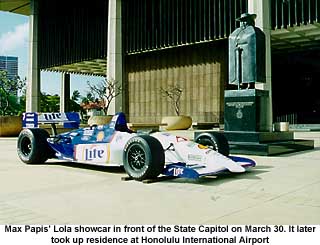Part 1 of 6: News of the Hawaiian Super Prix's cancellation on October 19, just 25 short days before the race's much-hyped inaugural running, came as a shock and surprise to some in the 50th State who had casually followed it over the past eight months. Others reacted with apathy, having seen little press or publicity for what promoters billed as the world's richest auto race. Meanwhile, many in the motorsports business took an "I told you so" stance, contending the Super Prix was doomed from the start. Racing pundits cite the late date of the Super Prix's formal announcement - February 25 of this year - as a fatal flaw, while others blame poor marketing and the fallacy of presenting this race as a Pay-Per-View television spectacle. Others responsible for the race's ultimate failure include CART, complications arising from the geographic nature of doing business in the middle of the Pacific Ocean, and reliance on a financial safety net riddled with gaping holes. In the end, regardless of who gets deemed at fault, none of the parties involved emerged unhurt. From dream to reality...almost Richard (Dick) Rutherford, Sr., an automotive engineer from Newport Beach, CA, has been involved with Indycar racing since 1971, including a friendship with Pat Patrick's family. He ran the Patrick-conceived American Racing Series (ARS), now Indy Lights, during its first two years of existence in 1986-87.

In the early 1990's, Rutherford spearheaded what was then known as the Hawaiian Super Gran Prix, an invitational race featuring a crop of international drivers from all forms of auto racing. Slated for January 24, 1993, the race would have used Shelby Can-Am sports cars on a temporary circuit around the perimeter of Aloha Stadium with a then-unprecedented $1 million purse for the winner. 13 name drivers - Mario and Michael Andretti, Martin Brundle, Erik Comas, Bill Elliott, Juan Fangio II, Steve Kinser, Hiro Matsushita, Riccardo Patrese, Kyle Petty, Michael Schumacher, Al Unser, Jr., and Derek Warwick - signed letters of intent, with three others rounding out the final field. But despite a smattering of press on ESPN's Speedweek and elsewhere, and the presence of Derek Daly and Patrick Tambay as consultants, the organizers fell far short of raising the necessary capital. The race never progressed beyond the stage of erecting a few concrete barriers in the stadium parking lot, and promoter Roy Tokujo wound up losing $2 million.
Over the next few years, Rutherford attempted getting the idea off the ground again, with the process reaching critical mass around 1996. In October 1998, with Rutherford telling the Honolulu Star-Bulletin "it's 99% sure it's going to happen," he issued a prospectus for the resurrected Super Prix touting a projected $79 to $85 million in revenue for Hawaii without asking the state for any money directly. He announced a whopping purse of $10 million, with $5 million alone to the winning driver. The figures far outgrossed those of both the Indianapolis 500 and Daytona 500, auto racing's two most prestigious events. The prospectus also mentioned the event would be broadcast by Showtime as a pay event - a negligible fact at the time that would grow like a cancerous tumor.
When Rutherford first made the Super Prix public, a number of fundamental issues remained unresolved, such as the track location (in a state with no professional level race course) and the sanctioning body. The HSP organization approached CART, which eagerly bought into the idea of having a much-needed marquee event that, in many respects, would replace the Indy 500.
Along the way, Rutherford attracted numerous high-dollar investors, including Bob Kachler (co-founder of the original Super Gran Prix proposal) and HSP President David Grayson, who jointly put up enough collateral to secure a $30 million performance bond from from Frontier Insurance Group of Tennessee. Phil Heard, who spent four years promoting CART's successful street course race in Vancouver, BC, and with similar experience at other Canadian CART and Formula 1 races, came aboard as General Manager the morning of February's big press conference.
CART's Andrew Craig and a slew of local politicians attending the kickoff along Waikiki Beach all had nothing but glowing praise and gleeful anticipation for the Super Prix. Governor Ben Cayetano, away at a conference off-island, commented in a press release that "the State of Hawaii is very pleased to host this new and exciting race event. We are grateful for the tax and charity dollars the HSP will generate and are prepared to provide the red carpet treatment for all the organizers and participants."
In the ensuing months, the public picture appeared rosy for the Super Prix, with the first CART showcar appearing on the front steps of the State Capitol on March 30. Andretti, now predominantly retired as a racing driver, resurfaced the following month as a paid spokesman for HSP, while Carl Haas signed on as a board member and investor. Mauricio Gugelmin made history by becoming the first to ever drive a CART Champ Car at speed in Hawaii, breaking in the Kalaeloa track at the former Barbers Point Naval Air Station on June 12. Andretti made his first local appearance for HSP the following month, extoling the virtues of the race and visiting military bases. The only local dissension came from the nearby Kapolei community, initially fearful about noise and traffic concerns on race weekend.
But behind the scenes and outside the Islands, trouble began brewing, and what began as ripples of discontent escalated into a storm of Biblical proportions that finally came ashore during hurricane season and washed away what Rutherford and company envisioned as the "Super Bowl" of racing.
So what happened?
Click here for Part 2 of 6: Timing is everything